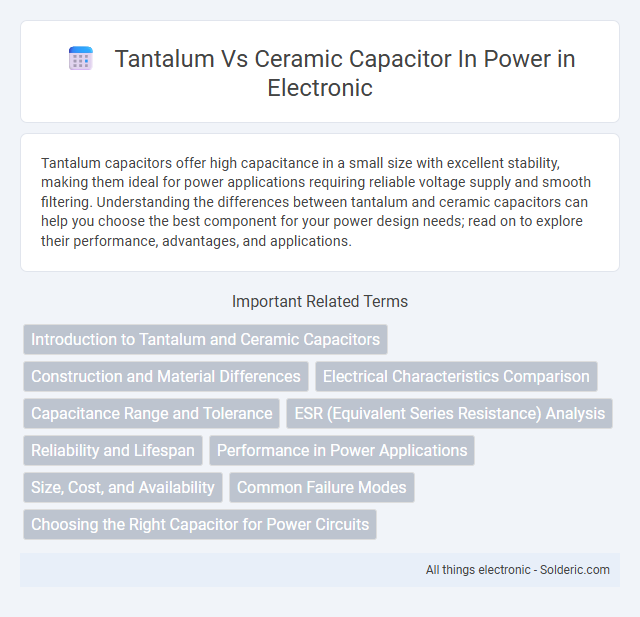Tantalum capacitors offer high capacitance in a small size with excellent stability, making them ideal for power applications requiring reliable voltage supply and smooth filtering. Understanding the differences between tantalum and ceramic capacitors can help you choose the best component for your power design needs; read on to explore their performance, advantages, and applications.
Comparison Table
| Feature | Tantalum Capacitor | Ceramic Capacitor |
|---|---|---|
| Material | Tantalum Metal Anode | Multi-layer Ceramic |
| Capacitance Range | 0.1 uF to 150 uF | 0.1 pF to 100 uF |
| Voltage Rating | Up to 50V (common) | Up to 500V+ |
| ESR (Equivalent Series Resistance) | Low ESR | Ultra-low ESR |
| Temperature Stability | Good (rated up to 125degC) | Excellent (varies by dielectric class, e.g., C0G, X7R) |
| Reliability | Susceptible to failure if voltage exceeded | High reliability, robust under surge |
| Cost | Moderate to High | Low to Moderate |
| Size | Compact, higher capacitance per volume | Very compact, suitable for SMD |
| Typical Applications | Power supply filtering, decoupling in low-frequency circuits | High-frequency decoupling, RF circuits, general filtering |
| Polarization | Polarized | Non-polarized |
Introduction to Tantalum and Ceramic Capacitors
Tantalum capacitors utilize a tantalum metal anode and an electrolytic solution, offering high capacitance per volume and stable performance in power applications. Ceramic capacitors consist of ceramic dielectric materials and metallic electrodes, providing low equivalent series resistance (ESR) and high-frequency response. Both capacitor types are essential in power circuits, with tantalum capacitors excelling in bulk energy storage and ceramic capacitors favored for decoupling and filtering tasks.
Construction and Material Differences
Tantalum capacitors feature a solid tantalum anode and manganese dioxide or polymer cathode, offering high volumetric efficiency and stable capacitance, while ceramic capacitors use ceramic dielectric materials with metal electrodes, providing excellent high-frequency performance and low equivalent series resistance (ESR). The construction of tantalum capacitors results in higher energy density and long-term reliability in power applications, whereas ceramic capacitors excel in handling high ripple currents and withstand voltage spikes due to their robust ceramic dielectric. Understanding these material and structural differences helps you select the optimal capacitor type for your power circuit's specific performance and reliability requirements.
Electrical Characteristics Comparison
Tantalum capacitors exhibit stable capacitance with low equivalent series resistance (ESR) and higher volumetric efficiency, making them suitable for low-noise power applications. Ceramic capacitors offer superior high-frequency performance and lower inductance, ideal for decoupling and filtering in power circuits. Your choice depends on balancing ESR, capacitance stability, and frequency response requirements in the power system design.
Capacitance Range and Tolerance
Tantalum capacitors typically offer capacitance values ranging from 0.1 uF to several hundred microfarads with tight tolerances as low as +-5%, making them suitable for stable power supply filtering and decoupling applications. Ceramic capacitors provide a broader capacitance range, from a few picofarads up to 100 uF, but often with wider tolerance levels, commonly +-10% or +-20%, depending on the dielectric class (such as X7R or C0G). The choice between tantalum and ceramic capacitors hinges on the required capacitance stability and precision within power circuits, where tantalum excels in consistent capacitance and ceramic offers more flexibility in value selection.
ESR (Equivalent Series Resistance) Analysis
Tantalum capacitors generally offer lower ESR compared to many ceramic capacitors, providing better performance in power supply filtering and smoothing applications. Ceramic capacitors, especially those using X7R or Y5V dielectrics, may exhibit higher ESR and voltage-dependent capacitance, affecting efficiency in high-frequency circuits. Your choice should consider ESR values carefully to optimize power delivery and minimize energy loss in sensitive electronic designs.
Reliability and Lifespan
Tantalum capacitors offer high reliability and stable capacitance over time, making them ideal for power applications requiring consistent performance under stressful conditions. Ceramic capacitors exhibit excellent lifespan due to their robust construction and low equivalent series resistance (ESR), but can suffer from micro-cracking under mechanical stress which affects reliability. In power systems, selecting between tantalum and ceramic capacitors depends heavily on the specific environmental and electrical demands, with tantalum preferred for long-term stability and ceramic for high frequency and temperature resilience.
Performance in Power Applications
Tantalum capacitors offer high volumetric efficiency and stable capacitance, making them suitable for power applications requiring low equivalent series resistance (ESR) and reliable performance over a wide temperature range. Ceramic capacitors provide excellent high-frequency characteristics and low losses, benefiting power circuits with fast transient responses and high ripple current handling. Power designers select tantalum capacitors for bulk energy storage and smooth DC output, while ceramic capacitors excel in decoupling and filtering due to their superior frequency stability and durability.
Size, Cost, and Availability
Tantalum capacitors offer high capacitance in a smaller size compared to ceramic capacitors, making them ideal for compact power applications. Ceramic capacitors are generally lower in cost and more readily available due to widespread manufacturing and diverse suppliers. However, tantalum capacitors provide better stability and reliability under higher voltage conditions, influencing their suitability despite higher costs and limited availability.
Common Failure Modes
Tantalum capacitors commonly fail due to dielectric breakdown, often caused by voltage spikes, resulting in short circuits or catastrophic failures. Ceramic capacitors typically experience cracks or fractures from mechanical stress or thermal cycling, leading to loss of capacitance or open circuits. Understanding these failure modes helps you select the right capacitor for reliable power applications.
Choosing the Right Capacitor for Power Circuits
Tantalum capacitors offer high capacitance in a small volume, ideal for stable voltage supply and low ESR requirements in power circuits, while ceramic capacitors excel in handling high-frequency noise and transient suppression due to their low parasitic inductance. Selecting the right capacitor depends on circuit needs: tantalum capacitors perform well in smoothing and filtering applications with steady current loads, whereas ceramic capacitors are preferred for decoupling and high-frequency applications. Combining both types can optimize power circuit performance by balancing energy storage, stability, and frequency response.
Tantalum vs Ceramic Capacitor in Power Infographic

 solderic.com
solderic.com